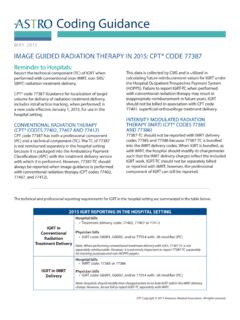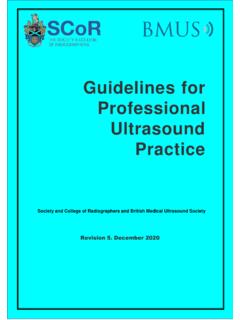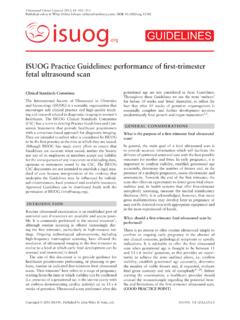Transcription of Coding Guidelines - American Society for Radiation Oncology
1 Image guided Radiation therapy (IGRT) involves the use of imaging technology to localize the intended target volume immediately prior to the administration of Radiation therapy. In IGRT, the external beam Radiation treatment setup is facilitated via an ultrasound , X-ray, or other image of the target volume, implanted fiducial markers and/or adjacent anatomical structure(s). These guidance images are compared to the images expected to be seen based on the planning scans obtained at the time of initial simulation. An adjustment in table position and/or patient orientation may then be required to deliver the Radiation dose accurately within the target volume inside the patient. IGRT is typically used in patients whose tumors are directly adjacent to critical structures and where conventional means of targeting are deemed to be inadequate.
2 IGRT must be performed by the Radiation oncologist, medical physicist or trained Radiation therapist under the supervision of the radia-tion oncologist. The physician must supervise and review the procedure, as the guidance may show a shift beyond standard tolerances. Stereotactic treatments, such as stereotactic radiosurgery (SRS), or stereotactic body Radiation therapy (SBRT) require the use of IGRT with each treatment for the precise localization of the intended treatment target. IGRT is consid-ered to be an inherent part of the SRS and SBRT procedure; for that reason, IGRT guidance should not be billed with SRS or SBRT GUIDED Radiation THERAPY Coding AND PHYSICIAN SUPERVISION GUIDELINESCOMMON CLINICAL INDICATIONSIGRT may be performed when using the following types of Radiation treatment delivery: Three-dimensional conformal therapy.
3 Intensity modulated Radiation therapy (IMRT). Particle beam therapy (Proton beam therapy or Neutron beam therapy). the absence of rigid external patient immobilization that fixes the target in a known location within a three-dimensional refer-ence space, IGRT is clinically indicated when using the follow-ing types of Radiation treatment delivery; image guidance is considered part of the procedure for these delivery techniques and cannot be billed separately: Stereotactic radiosurgery (SRS). Stereotactic body Radiation therapy (SBRT). IGRT allows Radiation oncologists to ensure that the target volume is treated with the planned dose of Radiation . Whenever a target volume is located near or within critical structures and/or in tissue with inherent setup variation, IGRT may be indicated to further the therapeutic ratio.
4 Such situations include where: The target volume is in close proximity to a critical organ at risk. The volume of interest must be covered with narrow margins to adequately protect immediately adjacent structures. Previous Radiation has been delivered adjacent to the target volume and high precision is required to avoid overlapping. Dose escalation is required above and beyond that which is commonly used for the same tumors with conventional fractionation. The clinical target volume is expected to vary in its location within the patient beyond what would be appropri-ately covered with a standard planning target Policy Coding GuidanceJANUARY 2013 ASTRO Health Policy Coding Guidance n PA G E 2 CLINICAL EXAMPLES OF IGRT BY TREATMENT MODALITYThe scenarios below are offered as examples and should not be considered a comprehensive list of all possible clinical conformal therapyIMRTP article beam therapyBrachytherapy SRS (IGRT is considered part of the SRS procedure and)
5 Cannot be billed separately.)SBRT (IGRT is considered part of the SBRT procedure and cannot be billed separately.)Extremely obese patient: morbidly obese patients with deep-seated tumors in the abdomen, pelvis or mediastinum may require daily IGRT for setup. For example, an obese patient receiving treatment to the para-aortic nodes may need IGRT for daily set-up in order to avoid treatment of the kidneys the skin markings may not be sufficient to localize the involves the use of multiple small beamlets directed to a target; because these beamlets may be very small (< 1 cm), it is necessary to ensure that the targeted volume is accurately positioned and localized. This is especially important when the treatment is given near organs with significant movement from day to day.
6 For example, with cervical cancer, the position of the cervix may vary daily because of the position/fill of the bladder, small bowel or rectum. The same is true for prostate cancer: when using IMRT it is necessary to ensure that the prostate is accurately targeted. Therefore, IGRT is required to precisely posi-tion the Radiation fields by localizing the treatment to the prostate, the desired treatment volume. This procedure is undertaken by visualizing implanted fiducial markers, aligning to bony anatomy, or visualizing the target by ultrasound or cone beam CT using proton beam therapy it is necessary to ensure accurate localization of the target before every treatment. Small variations in patient setup may cause significant differences in dose delivered to the tumor.
7 Therefore, IGRT is required to precisely position the radia-tion fields by localizing the treatment to the desired treatment volume for all patients prior to each treatment. This procedure is undertaken by visualizing implanted fiducial markers, aligning to bony anatomy, or visualizing the target ( prostate) by ultrasound or cone beam CT brachytherapy for prostate cancer requires very precise placement of radioactive seeds at planned positions within the prostate gland to ensure accurate dose coverage. This is typically accomplished with IGRT using real time transrectal ultrasonic guidance for inter-stitial radioelement application (CPT code 76965).CNS primary/secondary: SRS requires precise localization of the target volume within the brain because of the high Radiation doses coupled with the close proximity of critical struc-tures.
8 The Radiation oncologist utilizes IGRT to ensure that the target volume, or tumor, is accurately targeted prior to the delivery of each course of SRS. This can be achieved by CT imaging, as well as fiducial marker or bony anatomy utilizes very high doses of Radiation with highly accurate anatomic targeting. IGRT ensures that the treatment is precisely localized to the target volume within the lung, liver, spine or other targeted site. The localization of implanted fiducial markers, bony anatomy, and/or CT images is evaluated by the Radiation oncologist prior to the delivery of each fraction of Health Policy Coding Guidance n PA G E 3 CORRECT Coding AND PHYSICIAN SUPERVISION REQUIREMENTSThe following CPT codes are used to report IGRT with other Radiation Oncology therapy treatments.
9 The current Centers for Medicare and Medicaid Services (CMS) physician supervision requirements for these codes are provided as well. CPT CODE DESCRIPTION SUPERVISION LEVEL769507696577014 77421 0197 TUltrasonic guidance for placement of Radiation therapy fieldsUltrasonic guidance for interstitial radioelement applicationComputed tomography guidance for placement of Radiation therapy fieldsStereoscopic X-ray guidance for localization of target volume for the delivery of Radiation therapyIntra-fraction localization and tracking of target or patient motion during delivery of Radiation therapyGeneral SupervisionPersonal SupervisionDirect SupervisionDirect Supervision*Category III CPT* Effective January 1, 2009.
10 Updated in CMS transmittal 1748 All guidance procedures have both a professional and a techni-cal component. The technical component of all IGRT codes (CPT codes 76950, 76965, 77014 and 77421) performed in the hospital setting under the Outpatient Prospective Payment System (OPPS) has been packaged with the service for which it is provided; there is no separate payment for IGRT in the OPPS environment. ultrasound -based 2- and 3-D systems (CPT code 76950; ultra-sonic guidance for placement of Radiation therapy fields)Ultrasonic guidance for placement of Radiation therapy fields for prostate has been done with daily ultrasound localization for some time now. The physician work and practice expense costs for 76950 are not bundled into CPT code 77427 ( Radiation treatment management) or CPT codes 77401-77418 ( Radiation treatment delivery).















